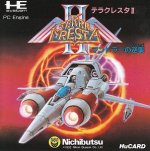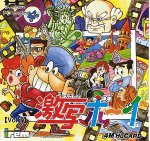Website Temporary Closed
PC Engine
The PC Engine was released by NEC, a Japanese company, in 1987. The PC Engine was a collaborative effort between Japanese software maker Hudson Soft (which maintains a chip-making division) and NEC. Hudson was looking for financial backing for a game console they had designed, and NEC was looking to get into the lucrative game market. The PC Engine was and is a very small video game console, due primarily to a very efficient three-chip architecture and its use of HuCards, credit-card sized data cartridges. It featured an enhanced MOS Technology 65C02 processor and a custom 16-bit graphics processor, as well as a custom video encoder chip, all designed by Hudson.
The PC Engine was extremely popular in Japan, beating Nintendo's Famicom in sales soon after its release, with no fewer than twelve systems released from 1987 to 1993. It was capable of up to 512 colours at once in several resolutions, and featured very robust sprite handling abilities. The Hudson-designed chroma encoder delivered a video signal more vibrant and colourful than both the Famicom and the Sega Mega Drive/Sega Genesis and is largely regarded as the equal to Nintendo's Super Famicom, although that system was not released until 1990.
[collapse collapsed title=read more...]
As graphics technology improved, gamers continued to stick to the PC Engine despite its shortcomings. Erotic games were a key factor in making the PC Engine popular, and this popularity was maintained far past the lifespan of a regular video game console. New games were released for the PC Engine up until 1999.
It was the first console to have an optional CD module, allowing the standard benefits of the CD medium: more storage, cheaper media costs, and redbook audio. The efficient design, backing of many of Japan's major software producers, and the additional CD ROM capabilities gave the PC Engine a very wide variety of software, with several hundred games for each the HuCard and CD formats.
All PC Engine systems support the same controller peripherals, including pads, joysticks and multitaps. Except for the Vistar, Shuttle, X1, GT and systems with built-in CD ROM drives all PC Engine units shared the same expansion connector, which allowed for the use of devices such as the CD ROM unit, game saves and AV output.
The US TurboGrafx and Vistar units use a different controller port than the PC Engines, but adaptors are available and the protocol is the same. The TurboGrafx offers the same expansion connector pinout as the PC Engine, but has a slightly different shape so peripherals must be modified to fit.
Despite the system's initial success, it soon lost ground to the Super Famicom. NEC made one final effort to resuscitate the system with the release of the Arcade Card expansion, bringing the total amount of RAM up to a then-massive 2048K; many Arcade Card games were conversions of popular Neo-Geo titles. The additional memory even allowed the system to display pre-rendered 3D polygon graphics well beyond what the competing Super Famicom and Megadrive/Mega-CD could offer. By this time, however, it was too late -- only a relative handful of Arcade Card games were ever produced, and the expansion was never released in the U.S.
In 1994 NEC released a new console, the Japan-only PC-FX, a 32-bit system with a tower-like design; it enjoyed a small but steady stream of games until 1998, when NEC finally abandoned the video games industry.
The PC Engine GT is a portable version of the PC Engine. It had a very crisp screen and an optional TV tuner was available. It could play all of the PC Engine HuCard games, yet had low battery life.
Another variation of the hardware is the SuperGrafx. This system is very nearly the same as the original PCE, except it has a duplicate set of video chips (and an extra chip to coordinate the two) and four times as much RAM. Since the CPU was not upgraded most developers were unable to utilize the extra graphics capability, the CPU just could not keep up. Only five SuperGrafx games (and one hybrid game - Darius) were released, and the system fell into obscurity.
Other members of the PC Engine family include the Shuttle, the LT (a laptop version similar to the Game Boy Advance SP, but considerably larger), the CoreGrafx I and II, the Duo R and the Duo RX. Contrary to popular belief the CoreGrafx is not a European version of the PC Engine. It is simply a reengineered version of the original (white) PC Engine with an AV output instead of the original model's RF output. The PC Engine and its derivatives were never officially sold in Europe, although many systems and most accessories and games were available as imports. The PC Engine and its games had been extensively covered by most major European video game magazines and were surprisingly popular.
[/collapse]
- HOME


- PRODUCTS

- 3DO
- Amiga CD32
- Amstrad GX4000
- Atari 2600
- Atari 7800
- Atari Jaguar
- Atari Jaguar CD
- Atari Lynx
- Bandai Wonderswan
- Coleco
- Colecovision
- Famicom
- Famicom Disk System
- Grandstand
- JAMMA
- Mattel Intellivision
- MB
- Microsoft Xbox
- MSX
- Neo Geo AES
- Neo Geo CD
- Neo Geo MVS
- Neo Geo Pocket
- Nintendo 64
- Nintendo Game and Watch
- Nintendo Gameboy
- Nintendo Gameboy Advance
- Nintendo Gameboy Colour
- Nintendo Gamecube
- Nintendo NES
- Nintendo Virtual Boy
- PC Engine
- PC Engine CD
- Philips CDI
- Sega 32X
- Sega Dreamcast
- Sega Game Gear
- Sega Genesis
- Sega Master System
- Sega Mega CD
- Sega Megadrive
- Sega Nomad
- Sega Saturn
- Sony Playstation
- Sony Playstation 2
- Super Famicom
- Super Nintendo
- Texas Instruments
- Tiger Game Com
- Tomy
- Vectrex
- Japanese Video Game Imports
-

- MODIFICATIONS

- Switchless Modification
- Modification Sega 32X
- Modification Sega Dreamcast
- Modification Sega Megadrive
- Modification Neo Geo AES
- Modification Neo Geo CD
- Modification Nintendo NES
- Modification Sega Master System
- Modification Sega Mega-CD
- Modification Sega Nomad
- Modification Sega Saturn
- Modification Super Nintendo
-

- TECHNICAL INFO


- NEWS


- ABOUT US


- MEMBERS


- CONTACT US


Log on
x
Just In!












 Save time
Save time